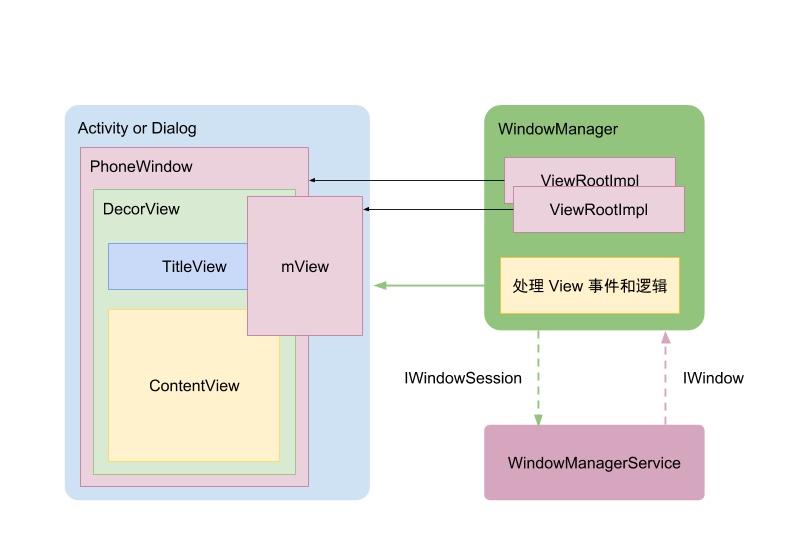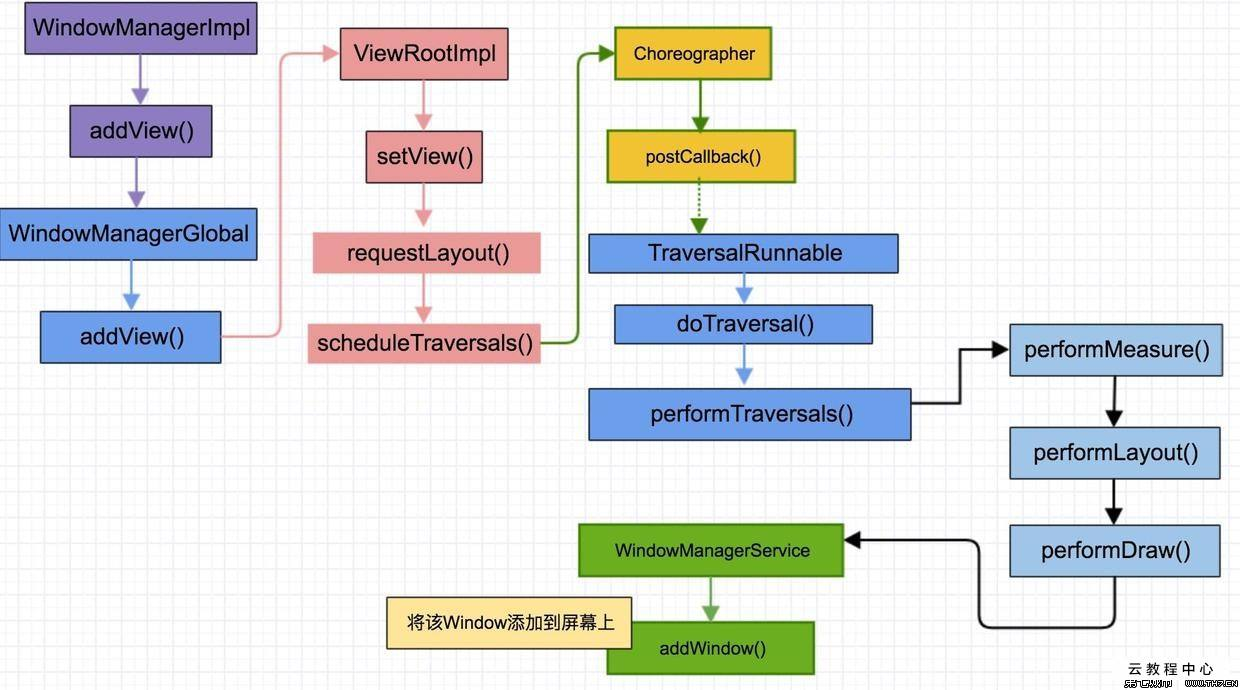一年多以前,曾经以为自己对 View 的添加显示逻辑已经有所了解了,事后发现也只是懂了些皮毛而已。经过一年多的实战,Android 和 Java 基础都有了提升,是时候该去看看 DecorView 的添加显示。
View 的绘制系列文章:
-
Android View 绘制流程之 DecorView 与 ViewRootImpl
-
Android View 的绘制流程之 Measure 过程详解 (一)
-
Android View 的绘制流程之 Layout 和 Draw 过程详解 (二)
-
Android View 的事件分发原理解析
概论
Android 中 Activity 是作为应用程序的载体存在,代表着一个完整的用户界面,提供了一个窗口来绘制各种视图,当 Activity 启动时,我们会通过 setContentView 方法来设置一个内容视图,这个内容视图就是用户看到的界面。那么 View 和 activity 是如何关联在一起的呢 ?

上图是 View 和 Activity 之间的关系。先解释图中一些类的作用以及相关关系:
-
Activity : 对于每一个 activity 都会有拥有一个 PhoneWindow。
- PhoneWindow :该类继承于 Window 类,是 Window 类的具体实现,即我们可以通过该类具体去绘制窗口。并且,该类内部包含了一个 DecorView 对象,该 DectorView 对象是所有应用窗口的根 View。
-
DecorView 是一个应用窗口的根容器,它本质上是一个 FrameLayout。DecorView 有唯一一个子 View,它是一个垂直 LinearLayout,包含两个子元素,一个是 TitleView( ActionBar 的容器),另一个是 ContentView(窗口内容的容器)。
-
ContentView :是一个 FrameLayout(android.R.id.content),我们平常用的 setContentView 就是设置它的子 View 。
- WindowManager : 是一个接口,里面常用的方法有:添加View,更新View和删除View。主要是用来管理 Window 的。WindowManager 具体的实现类是WindowManagerImpl。最终,WindowManagerImpl 会将业务交给 WindowManagerGlobal 来处理。
- WindowManagerService (WMS) : 负责管理各 app 窗口的创建,更新,删除, 显示顺序。运行在 system_server 进程。
ViewRootImpl :拥有 DecorView 的实例,通过该实例来控制 DecorView 绘制。ViewRootImpl 的一个内部类 W,实现了 IWindow 接口,IWindow 接口是供 WMS 使用的,WSM 通过调用 IWindow 一些方法,通过 Binder 通信的方式,最后执行到了 W 中对应的方法中。同样的,ViewRootImpl 通过 IWindowSession 来调用 WMS 的 Session 一些方法。Session 类继承自 IWindowSession.Stub,每一个应用进程都有一个唯一的 Session 对象与 WMS 通信。
DecorView 的创建
先从 Mainactivity 中的代码看起,首先是调用了 setContentView;
protected void onCreate(Bundle savedInstanceState) { super.onCreate(savedInstanceState); setContentView(R.layout.activity_main); }
该方法是父类 AppCompatActivity 的方法,最终会调用 AppCompatDelegateImpl 的 setContentView 方法:
// AppCompatDelegateImpl
public void setContentView(int resId) { this.ensureSubDecor(); ViewGroup contentParent = (ViewGroup)this.mSubDecor.findViewById(16908290); contentParent.removeAllViews(); LayoutInflater.from(this.mContext).inflate(resId, contentParent); this.mOriginalWindowCallback.onContentChanged(); }
ensureSubDecor 从字面理解就是创建 subDecorView,这个是根据主题来创建的,下文也会讲到。创建完以后,从中获取 contentParent,再将从 activity 传入的 id xml 布局添加到里面。不过大家注意的是,在添加之前先调用 removeAllViews() 方法,确保没有其他子 View 的干扰。
private void ensureSubDecor() { if (!this.mSubDecorInstalled) { this.mSubDecor = this.createSubDecor(); ...... } ...... }
最终会调用 createSubDecor() ,来看看里面的具体代码逻辑:
private ViewGroup createSubDecor() { // 1、获取主题参数,进行一些设置,包括标题,actionbar 等 TypedArray a = this.mContext.obtainStyledAttributes(styleable.AppCompatTheme); if (!a.hasValue(styleable.AppCompatTheme_windowActionBar)) { a.recycle(); throw new IllegalStateException("You need to use a Theme.AppCompat theme (or descendant) with this activity."); } else { if (a.getBoolean(styleable.AppCompatTheme_windowNoTitle, false)) { this.requestWindowFeature(1); } else if (a.getBoolean(styleable.AppCompatTheme_windowActionBar, false)) { this.requestWindowFeature(108); } if (a.getBoolean(styleable.AppCompatTheme_windowActionBarOverlay, false)) { this.requestWindowFeature(109); } if (a.getBoolean(styleable.AppCompatTheme_windowActionModeOverlay, false)) { this.requestWindowFeature(10); } this.mIsFloating = a.getBoolean(styleable.AppCompatTheme_android_windowIsFloating, false); a.recycle(); // 2、确保优先初始化 DecorView this.mWindow.getDecorView(); LayoutInflater inflater = LayoutInflater.from(this.mContext); ViewGroup subDecor = null; // 3、根据不同的设置来对 subDecor 进行初始化 if (!this.mWindowNoTitle) { if (this.mIsFloating) { subDecor = (ViewGroup)inflater.inflate(layout.abc_dialog_title_material, (ViewGroup)null); this.mHasActionBar = this.mOverlayActionBar = false; } else if (this.mHasActionBar) { TypedValue outValue = new TypedValue(); this.mContext.getTheme().resolveAttribute(attr.actionBarTheme, outValue, true); Object themedContext; if (outValue.resourceId != 0) { themedContext = new ContextThemeWrapper(this.mContext, outValue.resourceId); } else { themedContext = this.mContext; } subDecor = (ViewGroup)LayoutInflater.from((Context)themedContext).inflate(layout.abc_screen_toolbar, (ViewGroup)null); this.mDecorContentParent = (DecorContentParent)subDecor.findViewById(id.decor_content_parent); this.mDecorContentParent.setWindowCallback(this.getWindowCallback()); if (this.mOverlayActionBar) { this.mDecorContentParent.initFeature(109); } if (this.mFeatureProgress) { this.mDecorContentParent.initFeature(2); } if (this.mFeatureIndeterminateProgress) { this.mDecorContentParent.initFeature(5); } } } else { if (this.mOverlayActionMode) { subDecor = (ViewGroup)inflater.inflate(layout.abc_screen_simple_overlay_action_mode, (ViewGroup)null); } else { subDecor = (ViewGroup)inflater.inflate(layout.abc_screen_simple, (ViewGroup)null); } if (VERSION.SDK_INT >= 21) { ViewCompat.setOnApplyWindowInsetsListener(subDecor, new OnApplyWindowInsetsListener() { public WindowInsetsCompat onApplyWindowInsets(View v, WindowInsetsCompat insets) { int top = insets.getSystemWindowInsetTop(); int newTop = AppCompatDelegateImpl.this.updateStatusGuard(top); if (top != newTop) { insets = insets.replaceSystemWindowInsets(insets.getSystemWindowInsetLeft(), newTop, insets.getSystemWindowInsetRight(), insets.getSystemWindowInsetBottom()); } return ViewCompat.onApplyWindowInsets(v, insets); } }); } else { ((FitWindowsViewGroup)subDecor).setOnFitSystemWindowsListener(new OnFitSystemWindowsListener() { public void onFitSystemWindows(Rect insets) { insets.top = AppCompatDelegateImpl.this.updateStatusGuard(insets.top); } }); } } if (subDecor == null) { throw new IllegalArgumentException("AppCompat does not support the current theme features: { windowActionBar: " + this.mHasActionBar + ", windowActionBarOverlay: " + this.mOverlayActionBar + ", android:windowIsFloating: " + this.mIsFloating + ", windowActionModeOverlay: " + this.mOverlayActionMode + ", windowNoTitle: " + this.mWindowNoTitle + " }"); } else { if (this.mDecorContentParent == null) { this.mTitleView = (TextView)subDecor.findViewById(id.title); } ViewUtils.makeOptionalFitsSystemWindows(subDecor); ContentFrameLayout contentView = (ContentFrameLayout)subDecor.findViewById(id.action_bar_activity_content); ViewGroup windowContentView = (ViewGroup)this.mWindow.findViewById(16908290); if (windowContentView != null) { while(windowContentView.getChildCount() > 0) { View child = windowContentView.getChildAt(0); windowContentView.removeViewAt(0); contentView.addView(child); } windowContentView.setId(-1); contentView.setId(16908290); if (windowContentView instanceof FrameLayout) { ((FrameLayout)windowContentView).setForeground((Drawable)null); } } // 将 subDecor 添加到 DecorView 中 this.mWindow.setContentView(subDecor); contentView.setAttachListener(new OnAttachListener() { public void onAttachedFromWindow() { } public void onDetachedFromWindow() { AppCompatDelegateImpl.this.dismissPopups(); } }); return subDecor; } } }
上面的代码总结来说就是在做一件事,就是创建 subDecor。摊开来说具体如下:
1、根据用户选择的主题来设置一些显示特性,包括标题,actionbar 等。
2、根据不同特性来初始化 subDecor;对 subDecor 内部的子 View 进行初始化。
3、最后添加到 DecorView中。
添加的具体代码如下:此处是通过调用
// AppCompatDelegateImpl
this.mWindow.getDecorView();
// phoneWindow
public final View getDecorView() {
if (mDecor == null || mForceDecorInstall) {
installDecor();
}
return mDecor;
}
private void installDecor() {
mForceDecorInstall = false;
if (mDecor == null) {
// 生成 DecorView
mDecor = generateDecor(-1);
mDecor.setDescendantFocusability(ViewGroup.FOCUS_AFTER_DESCENDANTS);
mDecor.setIsRootNamespace(true);
if (!mInvalidatePanelMenuPosted && mInvalidatePanelMenuFeatures != 0) {
mDecor.postOnAnimation(mInvalidatePanelMenuRunnable);
}
} else {
// 这样 DecorView 就持有了window
mDecor.setWindow(this);
}
......
}
protected DecorView generateDecor(int featureId) {
// System process doesn't have application context and in that case we need to directly use
// the context we have. Otherwise we want the application context, so we don't cling to the
// activity.
Context context;
if (mUseDecorContext) {
Context applicationContext = getContext().getApplicationContext();
if (applicationContext == null) {
context = getContext();
} else {
context = new DecorContext(applicationContext, getContext());
if (mTheme != -1) {
context.setTheme(mTheme);
}
}
} else {
context = getContext();
}
return new DecorView(context, featureId, this, getAttributes());
}
到此,DecorView 的创建就讲完了。可是我们似乎并没有看到 DecorView 是被添加的,什么时候对用户可见的。
WindowManager
View 创建完以后,那 Decorview 是怎么添加到屏幕中去的呢?当然是 WindowManager 呢,那么是如何将 View 传到 WindowManager 中呢。
看 ActivityThread 中的 handleResumeActivity 方法:
// ActivityThread
public void handleResumeActivity(IBinder token, boolean finalStateRequest, boolean isForward, String reason) { ...... final int forwardBit = isForward ? WindowManager.LayoutParams.SOFT_INPUT_IS_FORWARD_NAVIGATION : 0; // If the window hasn't yet been added to the window manager, // and this guy didn't finish itself or start another activity, // then go ahead and add the window. boolean willBeVisible = !a.mStartedActivity; if (!willBeVisible) { try { willBeVisible = ActivityManager.getService().willActivityBeVisible( a.getActivityToken()); } catch (RemoteException e) { throw e.rethrowFromSystemServer(); } } if (r.window == null && !a.mFinished && willBeVisible) { r.window = r.activity.getWindow(); View decor = r.window.getDecorView(); decor.setVisibility(View.INVISIBLE); ViewManager wm = a.getWindowManager(); WindowManager.LayoutParams l = r.window.getAttributes(); a.mDecor = decor; l.type = WindowManager.LayoutParams.TYPE_BASE_APPLICATION; l.softInputMode |= forwardBit; ...... if (a.mVisibleFromClient) { if (!a.mWindowAdded) { a.mWindowAdded = true; wm.addView(decor, l); } else { // The activity will get a callback for this {@link LayoutParams} change // earlier. However, at that time the decor will not be set (this is set // in this method), so no action will be taken. This call ensures the // callback occurs with the decor set. a.onWindowAttributesChanged(l); } } // If the window has already been added, but during resume // we started another activity, then don't yet make the // window visible. } else if (!willBeVisible) { if (localLOGV) Slog.v(TAG, "Launch " + r + " mStartedActivity set"); r.hideForNow = true; } // Get rid of anything left hanging around. cleanUpPendingRemoveWindows(r, false /* force */); // The window is now visible if it has been added, we are not // simply finishing, and we are not starting another activity. if (!r.activity.mFinished && willBeVisible && r.activity.mDecor != null && !r.hideForNow) { if (r.newConfig != null) { performConfigurationChangedForActivity(r, r.newConfig); if (DEBUG_CONFIGURATION) { Slog.v(TAG, "Resuming activity " + r.activityInfo.name + " with newConfig " + r.activity.mCurrentConfig); } r.newConfig = null; } if (localLOGV) Slog.v(TAG, "Resuming " + r + " with isForward=" + isForward); WindowManager.LayoutParams l = r.window.getAttributes(); if ((l.softInputMode & WindowManager.LayoutParams.SOFT_INPUT_IS_FORWARD_NAVIGATION) != forwardBit) { l.softInputMode = (l.softInputMode & (~WindowManager.LayoutParams.SOFT_INPUT_IS_FORWARD_NAVIGATION)) | forwardBit; if (r.activity.mVisibleFromClient) { ViewManager wm = a.getWindowManager(); View decor = r.window.getDecorView(); wm.updateViewLayout(decor, l); } } r.activity.mVisibleFromServer = true; mNumVisibleActivities++; if (r.activity.mVisibleFromClient) { // 这里也会调用addview r.activity.makeVisible(); } } r.nextIdle = mNewActivities; mNewActivities = r; if (localLOGV) Slog.v(TAG, "Scheduling idle handler for " + r); Looper.myQueue().addIdleHandler(new Idler()); }
上面的代码主要做了以下几件事:
1、获取到 DecorView,设置不可见,然后通过 wm.addView(decor, l) 将 view 添加到 WindowManager;
2、在某些情况下,比如此时点击了输入框调起了键盘,就会调用 wm.updateViewLayout(decor, l) 来更新 View 的布局。
3、这些做完以后,会调用 activity 的 makeVisible ,让视图可见。如果此时 DecorView 没有添加到 WindowManager,那么会添加。
// Activity
void makeVisible() { if (!mWindowAdded) { ViewManager wm = getWindowManager(); wm.addView(mDecor, getWindow().getAttributes()); mWindowAdded = true; } mDecor.setVisibility(View.VISIBLE); }
接下来,看下 addview 的逻辑。 WindowManager 的实现类是 WindowManagerImpl,而它则是通过 WindowManagerGlobal 代理实现 addView 的,我们看下 addView 的方法:
// WindowManagerGlobal public void addView(View view, ViewGroup.LayoutParams params, Display display, Window parentWindow) { // ...... root = new ViewRootImpl(view.getContext(), display); view.setLayoutParams(wparams); mViews.add(view); mRoots.add(root); mParams.add(wparams); // do this last because it fires off messages to start doing things try { root.setView(view, wparams, panelParentView); } catch (RuntimeException e) { // BadTokenException or InvalidDisplayException, clean up. if (index >= 0) { removeViewLocked(index, true); } throw e; } }
在这里,实例化了 ViewRootImpl 。同时调用 ViewRootImpl 的 setView 方法来持有了 DecorView。此外这里还保存了 DecorView ,Params,以及 ViewRootImpl 的实例。
现在我们终于知道为啥 View 是在 OnResume 的时候可见的呢。
ViewRootImpl
实际上,View 的绘制是由 ViewRootImpl 来负责的。每个应用程序窗口的 DecorView 都有一个与之关联的 ViewRootImpl 对象,这种关联关系是由 WindowManager 来维护的。
先看 ViewRootImpl 的 setView 方法,该方法很长,我们将一些不重要的点注释掉:
/** * We have one child */ public void setView(View view, WindowManager.LayoutParams attrs, View panelParentView) { synchronized (this) { if (mView == null) { mView = view; ...... mAdded = true; int res; /* = WindowManagerImpl.ADD_OKAY; */ // Schedule the first layout -before- adding to the window // manager, to make sure we do the relayout before receiving // any other events from the system. requestLayout(); ...... } } }
这里先将 mView 保存了 DecorView 的实例,然后调用 requestLayout() 方法,以完成应用程序用户界面的初次布局。
public void requestLayout() { if (!mHandlingLayoutInLayoutRequest) { checkThread(); mLayoutRequested = true; scheduleTraversals(); } }
因为是 UI 绘制,所以一定要确保是在主线程进行的,checkThread 主要是做一个校验。接着调用 scheduleTraversals 开始计划绘制了。
void scheduleTraversals() { if (!mTraversalScheduled) { mTraversalScheduled = true; mTraversalBarrier = mHandler.getLooper().getQueue().postSyncBarrier(); mChoreographer.postCallback( Choreographer.CALLBACK_TRAVERSAL, mTraversalRunnable, null); if (!mUnbufferedInputDispatch) { scheduleConsumeBatchedInput(); } notifyRendererOfFramePending(); pokeDrawLockIfNeeded(); } }
这里主要关注两点:
mTraversalBarrier : Handler 的同步屏障。它的作用是可以拦截 Looper 对同步消息的获取和分发,加入同步屏障之后,Looper 只会获取和处理异步消息,如果没有异步消息那么就会进入阻塞状态。也就是说,对 View 绘制渲染的处理操作可以优先处理(设置为异步消息)。
mChoreographer: 编舞者。统一动画、输入和绘制时机。也是这章需要重点分析的内容。
mTraversalRunnable :TraversalRunnable 的实例,是一个Runnable,最终肯定会调用其 run 方法:
final class TraversalRunnable implements Runnable { @Override public void run() { doTraversal(); } }
doTraversal,如其名,开始绘制了,该方法内部最终会调用 performTraversals 进行绘制。
void doTraversal() { if (mTraversalScheduled) { mTraversalScheduled = false; mHandler.getLooper().getQueue().removeSyncBarrier(mTraversalBarrier); if (mProfile) { Debug.startMethodTracing("ViewAncestor"); } performTraversals(); if (mProfile) { Debug.stopMethodTracing(); mProfile = false; } } }
到此,DecorView 与 activity 之间的绑定关系就讲完了,下一章,将会介绍 performTraversals 所做的事情,也就是 View 绘制流程。
附上一张流程图:

到此,DecorView 与 ViewRootImpl 之间的关系就讲的很清楚了。
点击查看下一篇 Android View 的测量流程详解